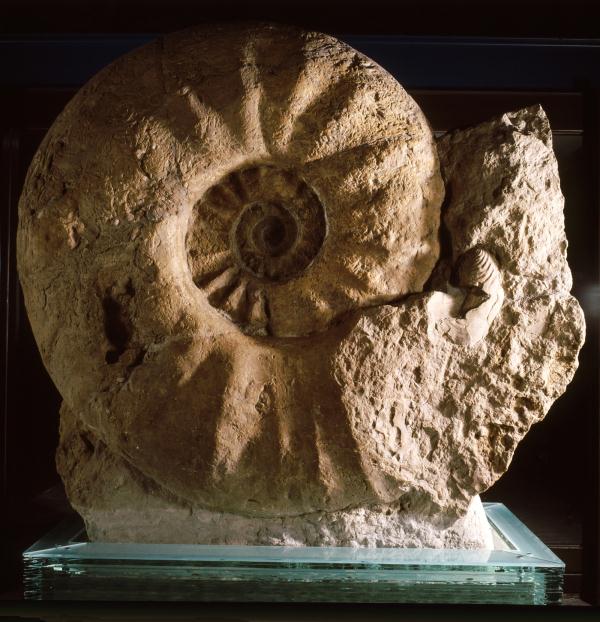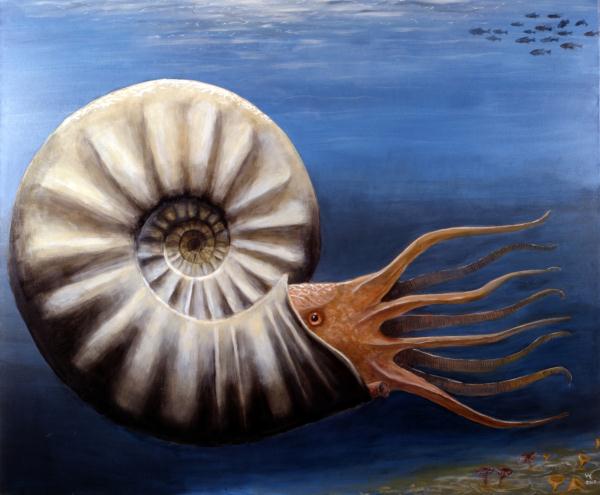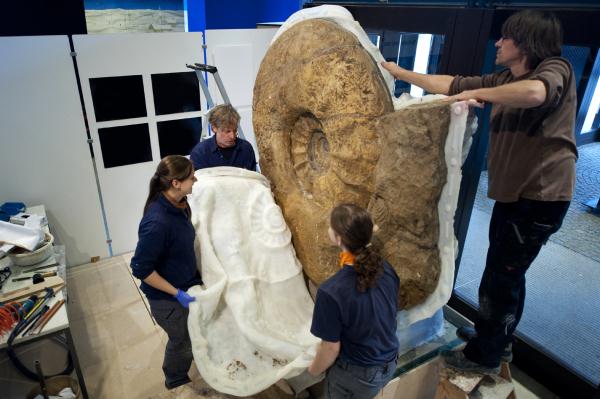English:
Ammonites are an extinct group of marine animals belonging to the
cephalopod subclass Ammonoidea. They lives from the Devonian until
Late Cretaceous (417 - 65 million years ago) all over the world.
Today living near relatives are coleoids, squid, octopus, and
cuttlefish. Their name came from their spiral shape somewhat
resemble tightly-coiled rams horns like the egyptian godhood
Ammon.
The soft body of the creature occupied the largest segments of the
shell at the end of the coil. The smaller earlier segments were
walled off and the animal could maintain its buoyancy by filling
them with gas. The shifting achieve by repulsion power.
They are main index fossils, and it is often possible to link the
rock layer in which they are found to specific geological time
periods. About 30.000 - 40.000 species are assumed. Therefore the
ammonites are very importent for geology.
Parapuzosia seppenradensis is the largest known species of
ammonite. A specimen found in Germany in 1895 measures 1.80 m in
diameter, although the living chamber is incomplete. It is
estimated that if complete, this specimen would have had a diameter
of approximately 2.55 m.
Many replicas of this Ammonite are standing in various museum
around the world and in the town, where it was found (Seppenrade,
near Münster, North Germany). The original is standing in the foyer
of the "LWL-Museum für Naturkunde" in Münster (the coordinate of
this cache) and it´s the logo of the museum.
Before log this cache, answer these questions via
e-mail:
1. Of which material consisted the Parapuzosia seppenradensis
shell?
2. The name of the man who nomenclature the Parapuzosia
seppenradensis the first time?
3. The number of glasplates of the supporting stand?
Alternative, when the foyer is closed: What is the name of the dino
infront of the main entrance?
Opening hours: Tuesday - Sunday 9.00 - 18.00
If possible, take an interesting photo of the exposition from the
"LWL-Museum für Naturkunde" (inside or outside) and add it to the
log. Inside without flash and stand!

Parapuzosia seppenradensis (Foto: LWL/Thomas)

Parapuzosia seppenradensis (Foto: LWL/Thomas)

Replic (Foto: LWL/Oblonczyk)
Deutsch:
Ammoniten sind eine ausgestorbene Gruppe von Meerestieren, die zu
der Gruppe der Kopffüßer und zu deren Untergruppe der Ammoniten
gehören. Sie lebten in der Zeit vom Unterdevon bis zur Oberkreide
(417 - 65 Millionen Jahre) überall auf der Erde. Die heutigen nahen
Verwandten sind Tintenfische, Kalmare, Kraken und Sepien. Ihr
Gehäuse ist eine in der Ebene aufgerollte Spirale ähnlich eines
Widderhorns. Abgeleitet wurde der Name von der ägyptischen Gottheit
Ammon, der mit Widderkopf dargestellt wurde.
Der weiche Teil des Körpers fand in dem großen offenen Bereich am
Ende der Spirale Platz. Die enger gewundenen inneren Bereiche waren
untereinander abgeschottet und wurden bei Bedarf mit Gas gefüllt
oder geflutet. Damit konnte der Ammonit im Wasser seine Tiefe
regeln. Das Fortkommen erfolgte mittels Rückstoßprinzip.
Die Ammoniten sind für die Geologie von besonderer Bedeutung, da
sie Leitfossilien sind. Das heißt, die Schichten in denen Ammoniten
vorkommen, können zeitlich zugeordnet werden. Es wird vermutet, das
30.000 bis 40.000 Arten vorgekommen sind. Alleine durch ihre
Biomasse und deren anschließenden Versteinerungen, haben sie die
Erde geprägt.
Parapuzosia seppenradensis ist die größte bekannte Ammoniten Art.
Ein Exemplar wurde 1895 mit einem Durchmesser von 1,80 Meter in
Deutschland gefunden, obwohl die äußere Wohnkammer nur teilweise
erhalten war. Im kompletten Zustand wäre der Durchmesser ca. 2,55
Meter groß gewesen.
Viele Kopien dieses Fundes befinden sich in Museen auf der ganzen
Welt. Auch in Seppenrade nahe Münster, dort wo das Original in
einem Steinbruch gefunden wurde. Das Original befindet sich im
Foyer des LWL-Museum für Naturkunde in Münster (die Koordinaten des
Caches) und es ist deren Logo.
Bevor du diesen Cache loggst, beantworte bitte diese Fragen
via e-mail:
1. Aus welchem Material bestand das Gehäuse der Parapuzosia
seppenradensis?
2. Wer vergab als erstes einen wissenschaftlichen Namen für den
Riesenammoniten?
3. Aus wie vielen Glassschichten besteht der Sockel auf dem der
Ammonit steht?
Alternativ, wenn das Museum geschlossen ist: Wie heißt die Dino-Art
vor dem Haupteingang?
Öffnungszeiten: Dienstag - Sonntag 9.00 - 18.00
Wenn ihr wollt, könnt ihr ein Foto von der Ausstellung des Museums
(auch außen) an eurem Log anhängen. Innen darf nicht mit Blitz und
Ständer fotografiert werden.